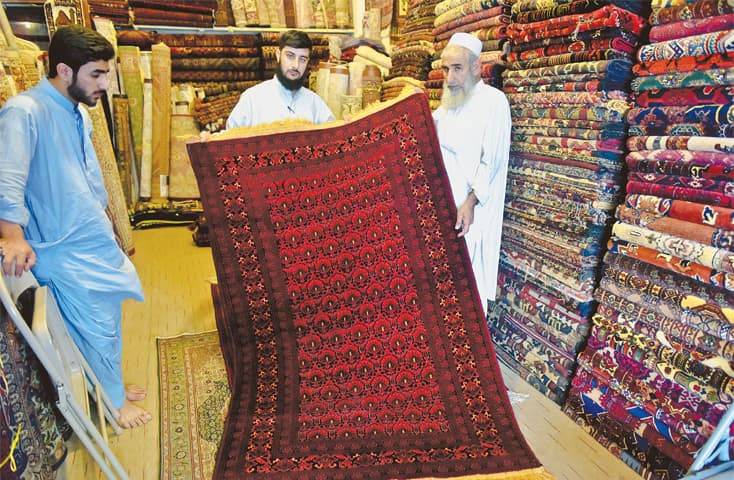
KARACHI: The images in the name of ‘design’ on a carpet in the window of a shop in a carpet market in Saddar makes you stop in your tracks and wonder. Why on earth would they want tanks, machine guns, rifles and fighter planes on them?
“Oh, it’s an Afghan carpet, my sister. Years of war there have left their mark on the mind of carpet makers, too,” says the young shop owner, Qudratullah, on being asked about it. “We have more of these inside too,” he says, inviting you inside his shop of carpets of all shapes, sizes and designs.

More Afghan handmade carpets include carpets showing maps of the world and flags. There is also one of the landmark defunct Twin Towers of the World Trade Centre of New York, but from the Afghan point of view it seems.

Qudratullah’s shop at the Karwan Carpet Centre deals in carpets from Balochistan, Kashmir, Iran and Bukhara in Uzbekistan, too. But the Afghan variety outnumbers the rest.
“Afghani carpets stand apart from the rest in quality,” says he. “It is made from yarn acquired from goats and sheep. Absolutely natural and clean, which will not affect health. And as they age, they turn into antiques, which adds to their value,” he explains.

“The other carpets, be they from Iran, China or even Pakistan, are mostly machine-made. The yarn used for weaving is also machine-made whereas for Afghan carpets the yarn is also spun by hand,” he says.
That’s why the Afghan carpets were thick and warm to the touch. There were also kilim, or rugs, from Afghanistan which were thin and smoother to the touch. “Well, the kilim is made with a needle while the carpets are made on looms,” the shop owner says.

The carpets come in various sizes, the smallest being 3ft x 5ft and the biggest 12ft x 18ft. “These are not your wall-to-wall carpets. You have the machine-made ones for that and these are to be spread over those,” says Qudratullah. “Also the size of a carpet does not determine its cost. Its quality does,” he adds. “The yarn can cost from Rs800 per kilogram to as expensive as Rs14,000 per kg. Wool acquired from the neck of a goat or sheep is particularly expensive,” he says.

The other carpets available in the market includes hanging carpets. Javed Rafiq deals only in those. Most of the hanging carpets in his shop have Islamic calligraphy. “But there is beautiful scenery too. There are pretty birds tweeting on tree branches. Fish in oceans, etc,” says the shop owner. “These carpets are for decoration. They should make you stop and admire them,” he adds.
All the hanging carpets in Rafiq Sahab’s shop are made in Sindh. And they are very popular with foreign customers from Saudi Arabia as well as other Muslims visiting from the United States or Singapore, he says.
Meanwhile, the market also has second-hand carpets for sale. “We call them lunda carpets,” says another carpet expert in the market. “You may not be able to recognise a second-hand carpet though. This is because most, including the Afghan and Iranian varieties, grow even more beautiful with time. But yes, the Kashmiri carpet made of silk yarn is identifiable as it loses its shine,” he says.

“Other things which you can look for when purchasing a carpet or sofa, chair or furniture with cigarette burn marks, which can give away its age and its not being new,” he says. “Because no one sells a perfectly nice hand-made carpet otherwise.”
Published in Dawn, March 4th, 2018












































Dear visitor, the comments section is undergoing an overhaul and will return soon.